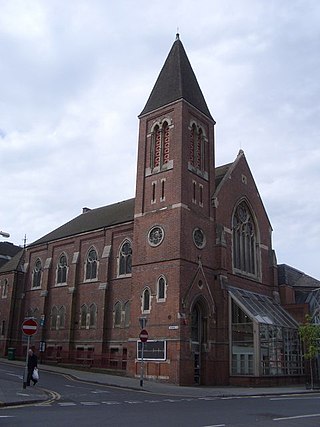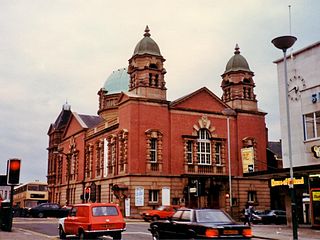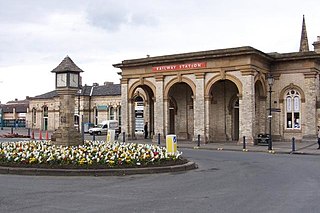

John Collyer (1840 - 12 August 1876) was an architect based in Nottingham.


John Collyer (1840 - 12 August 1876) was an architect based in Nottingham.
He was born in 1840 in Calverton, Nottinghamshire, the son of John Collyer and Sarah Windle. He established himself as an architect in Nottingham, initially in offices in Cobden Chambers, Market Street, then on South Parade, and from 1873 in Thurland Street.
He married Martha Sarah Adamson in 1866 in Southwell, Nottinghamshire. He died on 12 August 1876 aged 36. [1]

Watson Fothergill was a British architect who designed over 100 unique buildings in Nottingham in the East Midlands of England, his influences were mainly from the Gothic Revival and Old English vernacular architecture styles.

Albert Edward Lambert FRIBA was an architect based in Nottingham, England.

St George in the Meadows is a parish church in the Church of England in The Meadows, Nottingham, England.
Richard Charles Sutton was an architect based in Nottingham. He was born 1834 and died on 18 October 1915.

St Peter's Church, Radford is an Anglican parish church in Radford, Nottingham, located at 171 Hartley Road. It is a Grade II listed building as being of special architectural or historic interest.

Charles Lloyd was a pipe organ builder based in Nottingham who flourished between 1859 and 1908.
Emmanuel Church, Nottingham was a Church of England church in Nottingham on Woodborough Road between 1883 and 1972.
St. Thomas' Church, Nottingham was a Church of England church on Park Row in Nottingham between 1873 and 1926.

Radford railway station was on the Midland Main Line and Robin Hood Line in Radford, Nottingham.

Parliament Street Methodist Church is a Methodist church on Parliament Street in Nottingham.
Halixfax Place Wesleyan Chapel was a former Methodist Chapel in Nottingham from 1798 to 1930. The building dating from 1847 had the highest ceiling of any Wesleyan Methodist church in England. The building was finally demolished in 1966.

Arthur George Marshall ARIBA was an architect based in Nottingham from 1881.

The Nottingham and Nottinghamshire Bank was a joint stock bank which operated from its headquarters in Nottingham from 1834 to 1919.

Robert Clarke was an architect based in Nottingham.

Abraham Harrison Goodall LRIBA was a British architect based in Nottingham.

William Peachey was a British architect known for his work for the North Eastern Railway.

George Woodhouse was an English architect who practised from offices in Bolton, and Oldham, then in the county of Lancashire. He collaborated with William Hill on the designs for Bolton Town Hall.

Thomas Simpson was an English architect based in Nottingham.

Lieut-Colonel Herbert Walker FRIBA, M Inst CE, FSI, was an architect, surveyor and civil engineer based in Nottingham from 1870 to 1923.
Tennyson Street Methodist Church was a Methodist church at the junction of Tennyson Street and Larkdale Street, Nottingham from 1874 until 1941.